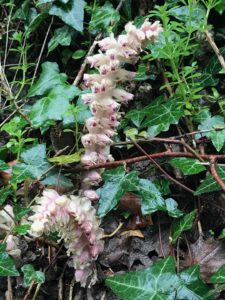Flora Selborniensis: Then and Now

In the tricentenary year of Gilbert White’s birth, we are carrying out a project to repeat the year-long document that became the Flora Selborniensis. White made regular observations of plants, particularly when they came into flower, during 1766. He also recorded what the weather was like and observed first appearances of birds, insects and a few other animals. The record of observations is known as the Flora Selborniensis (FS). During 2020, similar observations are being made around Selborne, and recorded alongside those of White.
After three months, to the end of March, some striking similarities and differences are emerging.
Some things are the same, with flooding being a problem and late frosts affecting plants brought on by warmer weather. The differences, as expected, are plants coming into flower, or blowing as Gilbert White (GW) would say, much earlier now than then. It also appears to confirm that birds are now producing young earlier in the year.
This being England, there is a lot of weather. There was very bad flooding in February in both 1766 and 2020, but it seems to have been a lot colder in Gilbert’s time. Selborne suffered a deep fall of snow late in March after some summer-like days in 1766.
Comparison:
1766 13 to 15 February “Continued rains that occasioned vast floods in some parts: in some parts the fall was a very deep snow; in others freezing rain which broke and defaces multitudes of trees.”
2020 15 and 16 February “Big storm, flooding and some trees down. And (strangely), a brown trout (Salmo trutta) was washed out of the well head stream onto the road.”
There are some instances where we can directly compare when flowers came into bloom then and now:
Primrose
1766 22 Feb, “the primrose, primula veris is also blowing.”
2020 1 Jan “Primrose (Primula vulgaris) in flower on the bank of the well-head stream.”
Dandelion
1766 11 March “Dandelion, dens leonis, blown.”
2020 18 Feb “Dandelion (taraxacum spp) in flower” (Since there are 400 species of dandelion this is a general name only)
Violet
1766 14 March “Blue and white violet, viola martia purpurea and alba blows.”
2020 4 March “Clump of violets (Viola riviniana) in flower on a bank this morning”
On 19 March 2020, toothwort (Lathrae Squamaria) was observed in flower and photographed. It doesn’t appear in the FS but was mentioned by GW on 4th May 1772 in Vol 1 of the Journals.

Birds, seen and heard, are mentioned by White, the difference being that the common names sometimes appear rather different from those used now – we don’t often refer to the titmouse (blue tit) or the shrike (mistle thrush). In 2020, there are observations of blackbirds and robins nesting, and a dunnock fledgling pestering its parents for food in March. White made no record of birds producing young during this time. So, another instance of spring events occurring slightly earlier now.
Garden plants are mentioned regularly by GW, in particular when fruit trees come into bud from March onwards, and there is quite a variety including apricot, peach and pear trees. The kitchen garden must have been an important source of fresh food in White’s time.
And finally, we cannot end without a mention of Covid 19. There is no mention of worries of any pandemic disease by GW, and you might not expect it in a record of flora and fauna. However White used to note in his diaries when illness was going round. Sickness from a great variety of diseases must have been a regular concern at that time. Are we now getting a taste of the dangers that affected everyone nearly 300 years ago?
